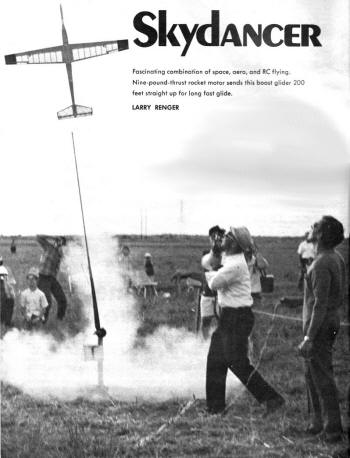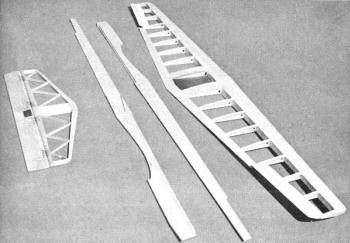|
Estes does not sell the D-13 engine line anymore, but it does sell
a D-12. The D-13 produced 9 pounds of thrust according to this article
and the
1971 Estes catalog (p94), whereas according to the
2014 Estes catalog the D-12 produces only 7.4 pounds (p79).
If you want similar performance with readily available rocket engines,
you will need to get them from a company like Aerotech, which makes
an
F30FJ-6 model that produces 9 pounds of thrust. With that solution
you're look at about $12 per launch. I believe that with modern
materials like graphite for spars and/or leading edges, and the
lightweight airborne systems, the flying weight could be significantly
reduced, and a much lower thrust (and cost) engine could be used,
particularly if the thrust duration was doubled or tripled over
the D-13 burn time of 1.6 seconds. For instance, the E-12 series
delivers 6.9 pounds of thrust for 2.7 seconds. A pack of three E-12
engines sells for around $26, so that brings the cost per flight
down to around $8-9. That's still a pretty high price from my perspective,
but people pay that for rocket launches all the time.
Here is my original
1971
Estes catalog.
Skydancer
Larry Renger
|

Fascinating combination of space, aero, and RC flying.
Nine-pound-thrust rocket motor sends this boost glider 200
feet straight up for long fast glide.
|
Have you ever seen a big dual-digital-proportional model blast
two hundred feet straight up under nine pounds of rocket thrust?
Skydancer is just such a breakthrough in the wide-open field of
RC boost-gliders. This model also has good duration coupled with
aerobatic capability following that spectacular launch! Its graceful
performance has earned it the name Skydancer.
This boost-glider is an experimental project by the Research
and Development staff at Estes Industries and was originally conceived
by John Simmance, Director of Model Products Development and five
times champion in scale at the British Nationals. The design, construction
and development of the model were assigned to me because my indoor
model and free-flight experience would aid in design of a light
airframe. I also had designed and flown RC slope soarers and had
originated both the front-engined boost glider and the "pop-pod."
Although NARAM 12, the Rocket Nats, was but four weeks away when
this assignment was given, it did seem possible to have the glider
ready for a demonstration at that annual meet. Construction took
two and one-half weeks from initial sketch to first flight, and
Bert Striegler, Technical Editor for Continental Oil Company, was
asked to fly Skydancer for a NARAM demonstration.
The model was test flown successfully several times at Estes'
Penrose, Colorado, test grounds. Then, just before Skydancer was
to be shipped to the Houston contest site, its wing was destroyed
when the ship collided with a power line. Enough had been learned
by then to develop a new, larger wing. The old wing had a 36-in.
span, which was now increased to 44 in. At the same time, 3/4 oz.
was cut out of the structure. After some late hours building, the
improved model was sent off to NARAM 12 only one day behind schedule.
With the help of Bill Simon, Executive Director of Research and
Development at Estes, Bert Striegler made several test flights and
found no serious problems. Despite high winds on the day of the
demonstration, Skydancer made a perfect flight before the assembly
at NARAM - a satisfying milestone in an interesting project.
Normally, Skydancer is powered by a single D-13-3 Estes engine
for a vertical flight of about 100 ft. The model is completely controllable,
even during the boost phase. Transition to glide is easy and smooth.
The best flight with the old 200-sq. in. wing at 12 1/4 oz. was
1:06. Using two-stage motors and the new wing, flight duration usually
has been over two min., even with an occasional loop thrown in.
Two Kraft KPS-12 servos, one 225 mah battery pack and a Kraft
three-channel receiver for an airborne weight of 6 1/2 oz. provide
aileron and elevator control. Although the equipment could have
been modified to further reduce weight, flying with off-the-shelf
gear was one of the project's goals. This model works quite well,
but it is just a starting point. The structure can be lightened
and the tradeoff of boost altitude versus glide must be investigated.
|

At last year's Rocketry Nats, the Skydancer was first
flown in public. Hold up-elevator during thrusting, then
turn into glide.

Skydancer is built like any model plane, but it must
be stronger to withstand acceleration and high speed in
launch.
|
All recent flights have been with a D-13-0 booster taped behind
the D-13-3. This is not legal for the NAR, nor is it good practice.
A true, legal, two-stage pod is next on the list for development.
One flight was attempted with twin clustered D-13-3 engines for
liftoff thrust of 18 lb. The model nosed over off the launch rail
and accelerated across the field at an altitude of about one foot
before the speed built up enough for the elevator to overpower the
nose down thrust moment. That experiment has not been repeated!
Construction: The wing, with the aileron servo,
is built first. Cut out forms for ribs R-1 and R-13; the forms should
be 1/32" undersize from the outline of the airfoil. Use 1/16" plywood
and cut in the spar notches. Sandwich balsa strips, alternating
1/32" for ribs and 1/8" for spacers, between the forms and pin it
all together. The two spacers between R-1 and R-2 and R-3 should
be 1/16" sheet, since the spacing is 1", not 2" as for the others.
Carve the block of ribs and spacers to shape, spar notches and
all, then repeat for the other wing; discard the spacers. Cut the
tapered spars out of hard 3/32" sheet.
Wing assembly by the following procedure will result in a warp-free
structure. Pin down the lower spar, glue all ribs in place, then
glue in the top spar. Ribs R-1 should be set to the dihedral joint
angle of 82 1/2 degrees. Glue the leading edges to the ribs. The
bottom of the LE should be pinned to the work-board and will act
as a jig later. Trim ribs R-10 through R-13 for the ailerons and
install the 3/16" trailing edge. Cut and glue the upper trailing
edge sheet in place.
Next, glue the two panels together, bracing them up to a dihedral
angle of 15 degrees. Cut rib R-1 to accept the dihedral brace and
glue it in.
Sheet the bottom of the wing and put in the cap strips. Do not
carve the LE yet. Pin one panel of the wing down, use the LE as
a jig, and sheet the top. Glue in the spar webs on that side now;
let it all set up hard before unpinning. Repeat for the other panel.
The wing should now be warp-free and remain so. Carve the LE to
shape and sand the wing smooth.
Cut away the area needed for the servo mount from R-1 and install
the servo, pushrods, bellcranks, etc. The pushrods on the original
are 8" lengths of Estes launch lug tubing (a very light. strong
5/32" mylar tube) with the 1/16" wire ends simply expoxied inside.
Set up the ailerons for about 25 degrees up and 10 degrees down
movement. Use a 1/2" horn on the elevator.
The remainder of the aircraft is standard construction except
for the pod and pod mount. The pod is a rear ejection model which
reduces the likelihood of a "Red Baron" where the streamer tangles
with the model. Two such situations arose with the original Skydancer.
In one instance, the pod hung up on the stabilizer but, with the
control available, the model landed safely.
The pod is built before the model so that the mount lugs fit
their sockets exactly. Dowels must be perfectly parallel to achieve
a smooth sliding fit. The shock cord must attach to the bottom rear
of the pod mount or the pod will tend to bind. Drill the holes in
the nose of the model well oversize and then use the pod itself,
well-coated with release agent, to cast the mount holes.
The model is launched from 18" of C-Rail; ignition by a standard
12V launch system. Two launch lugs are epoxied to the top of the
fuselage hatch cover, the remainder of the top of the cover is protected
by heavy silver foil.
Flying: Skydancer is a sensitive, neutral stability
model. When rolled to a bank it will stay there until rolled out.
Elevator must be used in conjunction with aileron for turns, but
the sharp turns are handy on landing approach.
Mild aerobatics are easy with this glider, although the flat
bottom airfoil limits the variety. It is great fun to loop by pushing
in a bit of down to gain speed then grab up for the loop. Little
altitude is lost because the ship can climb back almost to its starting
point after the maneuver.
Rolls can be done, but plenty of speed is needed. As she comes
over, push full down to prevent the nose from dropping. This takes
practice to get it right.
Inverted flying is also possible for those with strong nerves.
There is some nose down tendency as the model comes up from the
launch rail. Be ready to pull a small amount of up elevator at first,
but as the model accelerates, begin to hold the nose down to maintain
a 70 degrees to 80 degrees climb. The model is down to glide speed
at ejection so it should be nosed over to glide about 41h sec. after
final-stage ignition.

Estes Skydancer Rocket-Boost
R/C Glider Plans
Notice:
The AMA Plans Service offers a
full-size version of many of the plans show here at a very reasonable cost. They
will scale the plans any size for you. It is always best to buy printed plans because
my scanner versions often have distortions that can cause parts to fit poorly. Purchasing
plans also help to support the operation of the
Academy of Model Aeronautics - the #1
advocate for model aviation throughout the world. If the AMA no longer has this
plan on file, I will be glad to send you my higher resolution version.
Try my Scale Calculator for
Model Airplane Plans.
Posted October 4, 2014
|